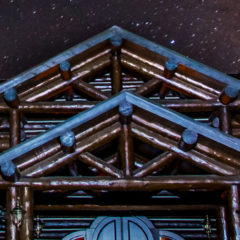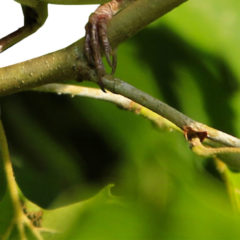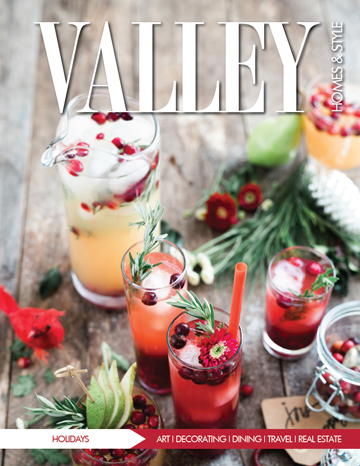Valley Homes & Style Magazine | December 2018 & January 2019 Edition
December 2018 & January 2019 Edition
A little bit of England right in the Eastern Panhandle
By Bonnie Williamson You don’t have to go across the pond (the Atlantic Ocean for those who don’t know) to get a taste of food well known to British palates. The Devonshire Arms Cafe and Pub at 107 S. Princess Street in Shepherdstown, West Virginia, combines the atmosphere of a pub serving tasty British fare and American favorites for the past nine years. The restaurant was named in honor of its owner’s home county in England, Devon or Devonshire. Carolyn Litwack was born in the city of Plymouth on the south coast of Devon about 240 miles from London. Litwack studied graphic design and worked in that field most of her life. She lived in different countries including Italy, Ireland and Iran before eventually coming to the states. She lived in Fairfax, Virginia, visited friends in Shepherdstown and purchased the building that was to become the future home of the Devonshire Arms. The structure was built in 1900, functioning as a site where horse drawn carriages were constructed and repaired. “I use my old traditional British recipes for the menu,” Litwack says. British dishes found on the menu include Bangers and Mash: two large English sausages (about the size of hotdogs), baked in Guinness, which is an Irish stout, mashed potatoes, gravy and baked beans or peas; Cornish Pasty and salad: beef, potato, onion with spices wrapped in pastry; Cottage Pie also known as Shepherd’s Pie: local beef cooked with white wine, carrots, peas, onions, and spices with a potato and cheese topping; and, of course, Fish and Chips: Yuengling battered haddock with hand cut English chips served with tartar sauce and coleslaw. Sometimes on special occasions Litwack will have something called Bubble and Squeak, a traditional British breakfast made from boiled potatoes and cabbage. “The cabbages squeak when they’re fried so that’s part of the name,” Litwack says. A breakfast item many Americans have never experienced is the Full English Breakfast or Fry Up: two eggs, bacon, sausages, home fries, grilled tomato, grilled mushrooms, baked beans, and toast. Some desserts offered include a Victoria sponge cake; a Bakewell tart, a short crust pastry shell beneath layers of jam, frangipane, and a topping of flaked almonds; sticky toffee pudding; and a Banoffee made from bananas, cream and toffee, combined either on a buttery biscuit base or one made from crumbled biscuits and butter with chocolate. Customers can celebrate special occasions with a traditional afternoon tea at the Devonshire. This usually takes place around 3 p.m. or 4 p.m. in the afternoon. Reservations are required for this treat, which consists of a pot of imported tea, scones, jam and Devonshire...
Say Cheese!
By Bonnie Williamson An unusual specialty market in Berkeley Springs, West Virginia, opened its doors this past Memorial Day and found residents of this rural community hidden in the hills greeting the new business with open arms. A plethora of cheeses are available, along with such meats as elk, venison, rabbit and boar. Not standard fare for local menus. The name of this establishment, Fleur De Lis Cheese Shop, is also quite different. Just what is going on? Fleur De Lis owner, self-proclaimed foodie Regina AaMacha, says despite the fact that cheese shops are not exactly found all over the region, people seek her out, both locals and out-of-towners. First, the name: why Fleur De Lis? The fleur-de-lis is a stylized lily that is used as a decorative design or motif used widely in France and New Orleans in the United States. Both places have significance for AaMacha. “I’ve been studying cheese for about 20 years, with time spent in France,” AaMacha says. “I traveled all over. I learned geography by eating cheese.” The New Orleans influence comes from her background, too. A Southern gal, born in Alabama but raised in the Baltimore/Washington, DC area, AaMacha learned how to make dishes from scratch from her grandmother. “When I was a teenager, my mother was into gourmet cooking,” she says. “What I do now is a combination of both.” AaMacha says the food business has always been a part of her life. Ironically, it’s directly connected to her other career. She has been performing as a working musician in bars, restaurants, clubs, concert halls and stadiums here and abroad since she was 16 years old. “I play guitar, eat and cook. Music and food have always been a part of what I do. I had a coffee shop in Florida. Same thing happened there, served people and performed. I travel on tours to keep things fresh musically. Has to be new, but cheese has also been a passion of mine,” she says. AaMacha offers a wide variety of cheese. “I find people want to have choices. Many come in knowing exactly what they want. Others come in to learn about cheese,” she says. When it comes to the flavor of cheese made from goat and cow’s milk, a lot depends on where the animal was grazing. Many cheeses are named for the region from which they originate. Chevre Noir is a Canadian made one-year aged goat milk cheddar. It’s an elegant, crisp cheese that develops a complex flavor dotted with lactose crystals during the aging process. Manchego is a cheese made in the La Mancha region of Spain from the...
Luxury in the hills of West Virginia
By Bonnie Williamson Majestic and luxurious are not words generally associated with log cabins. Rustic and visions of a simple structure that may have housed someone like Abraham Lincoln come to mind. A three-story, 8,400 square foot structure situated on 186 acres of pristine forest near Paw Paw, West Virginia, defies any preconceived notions about log cabins. After entering through an ornamental gate at Crooked Run Farm, which remains securely closed unless a visitor has permission to enter, one travels down a three-quarter mile paved driveway lined with unique street lights. At the end of the journey is one of the most solid and beautiful homes imaginable, containing just about every comfort a human being could ask for, comforts essential to the man who designed and lives in this unique structure: Michael R. Brown, 78. Brown lives in the house with his wife Tracey. “I knew what I wanted for a house” says Brown. “I didn’t want rustic. I wanted elegant. I wanted something solid that would last. I knew log cabins tended to be dark so I made sure we had plenty of large windows. I also wanted arches throughout the house: windows, doors and entry-ways. I just did that to give the house more character.” The logs used for the full-log construction were shipped in from Montana, carried in by eight 18-wheerlers. They are huge, thick and a very dark wood. The solidness and strength of the structure is attested to by the flagstone raised decks. “Whole log joist provided the strength,” Brown says. The front doors are solid cherry. The lighting in the tall foyer has sconces made by Brown’s nephew Coby Brown that represent oak leaves. Mountain stone used throughout the inside of the house and outside, including two fireplaces, came from just four miles down the road. The gambrel roof is copper. A gambrel roof is usually a symmetrical two-sided roof with two slopes on each side. “It avoids a boxy look,” Brown says. Ten-foot ceilings are throughout the home. The kitchen, which is 700 square feet, has granite counters from India. Marble from Spain is included in the master bath. The house has four bedrooms, including two master bedrooms; a library; a reading room, which is a bump-out or an extension of a room that creates a projection in a wall, has sturdy log posts framing its entry; Jacuzzis in the bathrooms; a three-car garage, not to mention a gym, including a sauna; and a dumbwaiter that carries laundry between the master bedroom linen closet and the main floor laundry room. Large walk-in closets abound and there is what Brown refers to as...
Birding in the Valley
by Alex A. Tsiatsos On a cold and windy Saturday in November, fifteen people arrived at the United States Geological Survey (USGS) Fish Health Lab in Leetown, West Virginia at 7:30 in the morning. After an introductory huddle, the group started moving along trails through the still-vibrant foliage, past large, quiet ponds and ultimately into the deep, reedy recesses of the property’s hidden watercourses. “There!” someone shouted, and, in an instant, fifteen pairs of binoculars searched for a small brown bird darting among the cattails and low shrubs. “Song Sparrow?” asked one member of the group. “I think it was a Swamp Sparrow,” said another, and the matter was settled by comparing illustrations in ready at hand field guides. That wasn’t the first time that field guides made an appearance that day. An American Black Duck with an unusual bill also temporarily stumped the participants. But because undisturbed ducks meander leisurely compared with ever-nervous sparrows, the group was able to set up a spotting scope to allow magnified looks at this uncommon, inconspicuous bird – a species that most people rarely notice. Finding uncommon birds hiding in unexpected places is one of the great joys of birding – an activity which used to be called “birdwatching,” still an acceptable term, but one that has fallen into disfavor in part because of its passive connotations. And, truthfully, birding on that particular morning was anything but passive. The group trekked across miles of cold, wet terrain, up and down hills and through muddy passes to try to tally as many different birds as possible. In fact, those without appropriate footwear (specifically, this author) had trouble keeping up. The trip was organized by the Potomac Valley Audubon Society (PVAS). Christine Densmore, a USGS Veterinary Medical Officer, graciously chaperoned the group on the federal site. While the primary purpose of the Leetown USGS facility is to study and promote fish health, its expansive grounds, filled with ponds and other bird-friendly environments, makes it an ideal location for birding. PVAS host trips to different locations throughout the year. Trips in the spring, when songbirds in technicolor plumage migrate through the treetops like little, flying jewels, are especially popular. The outings are usually open to all members of the public (provided they reserve a space) and, on this particular day, the group featured birders of all ages and experience levels. The group’s friendly and knowledgeable leader Beth Poole, a PVAS volunteer, is a retired teacher who took up birding approximately ten years ago. She credits her mother, who used to watch the birds that came to the family bird feeder, for sparking her own interest...






